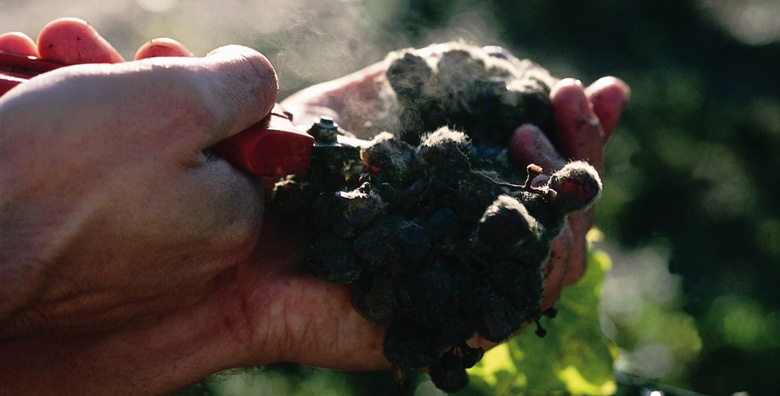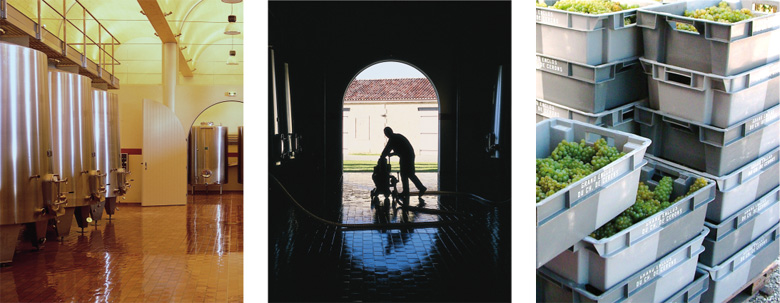Winegrower Bordelais Grand Enclos du Château de Cérons
An adventure, a revival
They are three to welcome me in this winter morning. Three different and complementary men who are going to tell me love and adventure. Three characters united by a same passion for the wines of the Château du Grand Enclos de Cérons.
 Bertrand Léon, Giorgio Cavanna and Francis Unique
Bertrand Léon, Giorgio Cavanna and Francis Unique 
The first is Giorgio Cavanna, direct and energetic, the Italian engineer who likes to take up challenges. Then Bertrand Léon, the oenologist, more reserved but whose eyes sparkle when he speaks about varietal and terroir. And Francis Unique, enthusiastic business executive who is in charge of the marketing of the domain's wines and is so good in finding the words to praise them.
His passion for wine caught Giorgio Cavanna in his early years. In 1973, his father and some associates unite to restore and run an estate that produces Chianti Classico in Tuscany, between Sienna and Florence. They were good food and good wine lovers, but novice in viticulture. They faced some technical difficulties until 1981 when they meet Patrick Léon, an oenologist with unequalled experience in making the greatest wines of the world, who was then working for Alexis Lichine. With his help, a groundwork coupled with an intense trade development made the wine of Castello di Ama become one of the most renowned reds in Italy.
An audacious challenge
A deep friendship appeared between both families, children grew up... When his father died, Giorgio Cavanna felt like running his own project “in a region that has always been an ideal with regards to quality, culture, the science of wine: Bordeaux”. It is Bertrand Léon, Patrick's son, who will find the real treasure. One day, in the beginning of 2000, during a lunch, he speaks with Giorgio Cavanna about an estate in the Graves, near the family domain in Fronsac he is in charge of. But the Grand Enclos de Cérons, with its ten hectares encircled with a three-meter high stone wall in the core of the village and the 16 hectares located on the plateau of Podensac, is escheated. Whatever! The domain has a very good potential: it produces at the same time white, red and sweet wines. Passion prevailed and Giorgio Cavanna, seduced, takes up the audacious challenge “with the pleasure to defy the impossible, aiming at a highly qualitative objective.”.

A real groundwork
The two men share the same taste for wine. They boost the vineyard and modernize the installations. A copper roofed stone vatroom with thermoregulated stainless steel vats is built in 2002 at the entrance of the property. The barrel winery, extended and renovated with a stunning aesthetic, worthy of a classed grand cru, gives the wines the time to age peacefully. The technical tool is remarkable.
But to give back the Domain its grandness, the vineyard had to be reorganized:
“We have very old vines?even 70-year old Sémillons that give a big part of its quality to the sweet Cérons?and some bit more recent ones. We planted there were it was possible. We have pulled out and planted again very old plots which had a lot of lacks. Initially this region is a region for white and sweet wines. At the beginning, there were not many reds, only 4 hectares. Today we exploit 15. We carried out overgrafting on younger vines in Merlot/Cabernet to establish the basis of the vineyard in red.” Giorgio Cavanna explains.

A philosophy
The research for quality starts in the vines. Here the former chemical treatments are left aside. Ploughing, canopy management and harvest are hand-controlled again. The vine so carefully worked gives back what it receives by providing perfectly healthy grapes, that will be picked selectively into small boxes then sorted again as they come into the winery. Man will then be able to make exceptional wines, in a perfect expression of the terroir. The red wines of Grand Enclos de Cérons have this ambition. These wines, with a velvety bouquet, racy, powerful and with an ideal balance, will get, while ageing, all the nobleness their position commands.
“The current trend is to abound with Merlot which is more flattering. Without trying to distinguish ourselves, we choose to keep a balance of 50% Merlot and 50% Cabernet to maintain the spirit, the spine which is made up with the Cabernet on gravels. After, we of course have to adapt according to each vintage.” Bertrand Léon states.
“We respect the work done during many years by the winegrowers of the Bordeaux region but we fundamentally want to make the wines we like. One could name us 'viticultural integrists', so we tried. Of course, the Merlot is an easier varietal, we tend to put some more to be closer to the market … but after 10 years of strong hold of the vines, we note that once the Cabernet has recovered its real strength, the best wine at blending is the one in which this variety is really present. It has ageing and gustative qualities. And today we extract better, the wines
are rounder, more ready-to-drink but that are still good for laying down. Thus the progress finally brings back to classics, to expressions like 'in the old days', more elegant, finer… another taste!” Giorgio Cavanna adds with a smile.
“With the dry white wines, it is the same, we will not submit to the desires of the market who wants ready-to-drink wines, with a lot of Sauvignon, which are very pleasurable when young as they are more aromatic, fresher. We keep a significant part of Sémillon, 50 to 60%, as it gives the wine all its 'skeleton', its legitimity. We want to make a dry white wine with good ageing potential, that will give the best after a year in the bottle. It needs a little time to refine, but after, these are wines that can age 5, 6, 7 years without any problem.” Bertrand resumes.
A revival
“I came into the adventure under way as I joined the team in 2007,” Francis Unique explains,
“and I am a kind of spokesman of all the work and philosophy of the estate. This loyalty to difficult varietals bear fruit: vintage after vintage our wines gain delicacy, complexity, expression. Today, very modestly, we are one the references of the region for white wines. Same thing for the sweet wines. It is a very confidential appellation, one of the tiniest AOCs in the world, but that gives wines which story tells a quality that can be compared to the Grands Crus of Sauternes. For the red wine, the road has been long but, at last, the result is there, with wines of great depth and complexity. It is now more a matter of recognition among the huge supply in Bordeaux.
We are very proud to notice our 2000s are still 'wealthy' even if it is our first vintage. And finally the truth always is to be found in the bottle...” “It is a great adventure, a revival, because even if 10 years is still very young, in the viticultural world, it is a first step. My
father taught me: 5 years is a first stock… 10 years, you cannot hide anymore! The vine is like a bonsai: during 10 years, we fashioned it, we affixed our signature, the direction to take. We imparted to the vineyard the movement we wanted to give it, and we can totally claim the quality of our wines.” Bertrand Léon adds.
How much fire, hopes and willpower in these three men who raise the Grand Enclos du Château de Cérons among the circle of the best, and who sum up their philosophy in a laughter and a short sentence:
“We are driven with passion, we fight!!!”
Dominique Peyral-Bon

Grand Enclos du Château de Cérons
12, Place Charles de Gaulle
33720 Cérons
Tél. +33-5-56-270153
www.le-grand-enclos.com
 The first is Giorgio Cavanna, direct and energetic, the Italian engineer who likes to take up challenges. Then Bertrand Léon, the oenologist, more reserved but whose eyes sparkle when he speaks about varietal and terroir. And Francis Unique, enthusiastic business executive who is in charge of the marketing of the domain's wines and is so good in finding the words to praise them.
The first is Giorgio Cavanna, direct and energetic, the Italian engineer who likes to take up challenges. Then Bertrand Léon, the oenologist, more reserved but whose eyes sparkle when he speaks about varietal and terroir. And Francis Unique, enthusiastic business executive who is in charge of the marketing of the domain's wines and is so good in finding the words to praise them.

